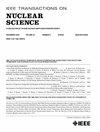Trikarenos: Design and Experimental Characterization of a Fault-Tolerant 28-nm RISC-V-Based SoC
IF 1.9
3区 工程技术
Q3 ENGINEERING, ELECTRICAL & ELECTRONIC
引用次数: 0
Abstract
RISC-V-based fault-tolerant system-on-chip (SoC) designs are critical for the new generation of automotive and space SoC architectures. However, reliability assessment requires characterization under controlled radiation doses to accurately quantify the fault tolerance of the fabricated designs. This work analyzes the Trikarenos design, an SoC implemented in TSMC 28 nm, for single event upset (SEU) vulnerability under atmospheric neutron and 200-MeV proton radiation, comparing these results to simulation-based fault injection. All faults in error correction codes (ECCs) protected memory are corrected by a scrubber, showing an estimated cross section per bit of up toTrikarenos:基于risc - v的28纳米容错SoC的设计与实验表征
基于risc - v的容错片上系统(SoC)设计对于新一代汽车和空间SoC架构至关重要。然而,可靠性评估需要在受控辐射剂量下进行表征,以准确量化制造设计的容错能力。本文分析了台积电28纳米芯片Trikarenos设计在大气中子和200 mev质子辐射下的单事件破坏(SEU)脆弱性,并将这些结果与基于模拟的故障注入进行了比较。纠错码(ecc)保护的存储器中的所有故障都由洗涤器纠正,显示每比特的估计横截面高达$1.09\乘以10^{-14}$ cm2bit−1。此外,在Trikarenos中实现的三核锁步(TCLS)机制得到了验证,并被证明可以纠正影响横截面的错误高达$3.23\times 10^{-11}$ cm2,其余无法纠正的漏洞低于$5.36\times 10^{-12}$ cm2。在模拟中,通过栅极级故障注入对制程芯片进行实验分析,99.10%的SoC注入结果正确,而100%的tcls保护内核注入结果正确。由于12.28%的注入断层导致TCLS恢复,这表明有效触发器(FF)的近似横截面高达1.28\乘以10^{-14}$ cm2/FF。
本文章由计算机程序翻译,如有差异,请以英文原文为准。
求助全文
约1分钟内获得全文
求助全文
来源期刊

IEEE Transactions on Nuclear Science
工程技术-工程:电子与电气
CiteScore
3.70
自引率
27.80%
发文量
314
审稿时长
6.2 months
期刊介绍:
The IEEE Transactions on Nuclear Science is a publication of the IEEE Nuclear and Plasma Sciences Society. It is viewed as the primary source of technical information in many of the areas it covers. As judged by JCR impact factor, TNS consistently ranks in the top five journals in the category of Nuclear Science & Technology. It has one of the higher immediacy indices, indicating that the information it publishes is viewed as timely, and has a relatively long citation half-life, indicating that the published information also is viewed as valuable for a number of years.
The IEEE Transactions on Nuclear Science is published bimonthly. Its scope includes all aspects of the theory and application of nuclear science and engineering. It focuses on instrumentation for the detection and measurement of ionizing radiation; particle accelerators and their controls; nuclear medicine and its application; effects of radiation on materials, components, and systems; reactor instrumentation and controls; and measurement of radiation in space.
 求助内容:
求助内容: 应助结果提醒方式:
应助结果提醒方式:


